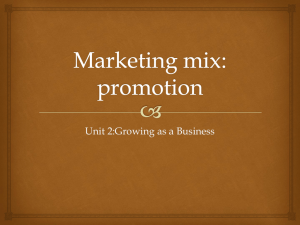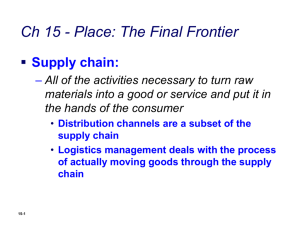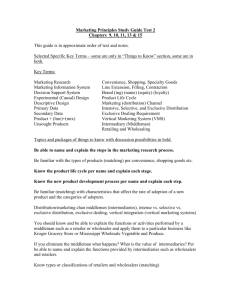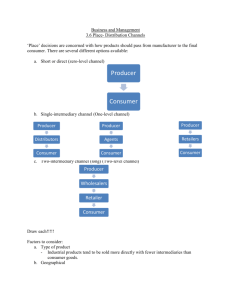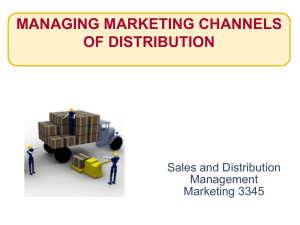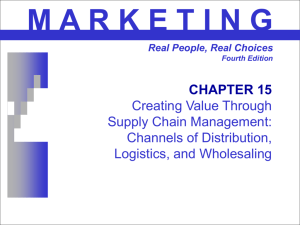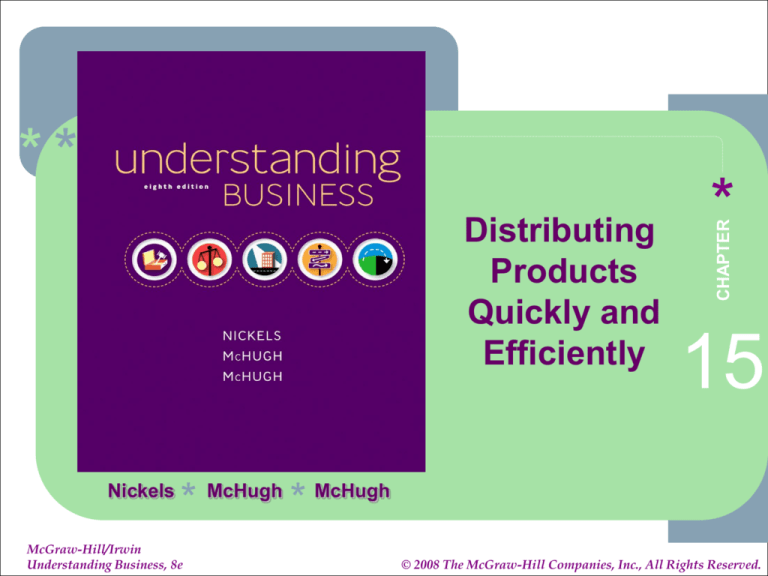
*
*
*
Distributing
Products
Quickly and
Efficiently
Nickels
*
McGraw-Hill/Irwin
Understanding Business, 8e
McHugh
*
*
CHAPTER
**
15
McHugh
1-1
15-1
© 2008 The McGraw-Hill Companies, Inc., All Rights Reserved.
*
*
*
I THE EMERGENCE OF MARKETING INTERMEDIARIES
Learning goal 1
Explain the concept of marketing channels and the
value of marketing intermediaries.
Why Marketing Needs Intermediaries
How Intermediaries Create Exchange Efficiency
The Value versus the Cost of Intermediaries
15-2
*
*
*
They All Started in 1962
Company
1st Store
Goal
Wal-Mart
Rogers, Ark.
Slash prices. Makeup
July 1962
difference in volume
Target
Roseville, MN
Discount retailer with
May 1962
strong sense of value
Kmart
Garden City, MI
Bring discount store
concept to suburban
malls
March 1962
Source: walmart.com, target.com, kmart.com; Business 2.0, June 2003
15-3
*
*
*
II THE UTILITIES CREATED BY INTERMEDIARIES
Learning goal 2
Form Utility
Time Utility
Place Utility
Possession Utility
Information Utility
Service Utility
15-4
*
*
*
III.
WHOLESALE INTERMEDIARIES
Learning goal 3
Describe the various wholesale intermediaries in the
distribution system.
Merchant Wholesalers
Agent and Brokers
15-5
*
*
*
IV. RETAIL INTERMEDIARIES
Learning goal 4
Explain the distribution strategies retailers use.
Retail Distribution Strategy
Non-store Retailing
Learning goal 5
Explain the various kinds of non-store retailing.
Electronic Retailing
Telemarketing
Vending Machines, Kiosks, and Carts
Direct Selling
Multilevel Marketing
Direct Marketing
15-6
*
*
*
V. BUILDING COOPERATION IN CHANNEL SYSTEMS
Learning goal 6
Explain the various ways to build cooperation in channel
systems.
Corporate Distribution Systems
Contract Distribution Systems
Administered Distribution Systems
Supply Chains
VI.
THE EMERGENCE OF LOGISTICS
Learning goal 7
Describe the emergence of logistics.
15-7
*
*
*
VII.
GETTING GOODS FROM PRODUCER TO
CONSUMER EFFICIENTLY
Learning goal 8
Outline how intermediaries move goods from producers
to consumers through the use of various
transportation modes and storage functions.
Choosing the Right Transportation Mode
Trains Are Great for Large Shipments.
Trucks Are Good for Small Shipments to Remote
Locations.
Water Transportation Is Inexpensive but Slow.
Pipelines Are Fast and Efficient.
Air Transportation Is Really Fast but Expensive.
Intermodal Shipping
The Storage Function
15-8
*
*
*
VIII.
WHAT ALL THIS MEANS TO YOU
15-9
*
*
*
THE EMERGENCE OF MARKETING INTERMEDIARIES
learning goal 1
Explain the concept of marketing channels and the
value of marketing intermediaries.
THE IMPORTANCE OF DISTRIBUTION
There are hundreds of thousands of marketing
intermediaries whose job it is to help move goods
through the distribution network from producer to
customers.
15-10
*
*
*
MARKETING INTERMEDIARIES
are organizations that assist in moving goods and services from
producer to business and consumer users (often called
middlemen).
These are organizations in the middle of a series of organizations
that distribute goods from producer to consumer.
A CHANNEL OF DISTRIBUTION
is the whole series of marketing intermediaries, such as
wholesalers and retailers, that join together to transport and store
goods in their path (or channel) from producers to consumers.
AGENTS/BROKERS
are marketing intermediaries who bring buyers and sellers
together and assist in negotiating an exchange, but do not take
title to the goods.
15-11
*
*
*
WHOLESALER
is a marketing intermediary that sells to other organizations.
A RETAILER
is an organization that sells to ultimate consumers.
CHANNELS OF DISTRIBUTION
enhance communication flows and the flow of money and title to
goods.
WHY MARKETING NEED INTERMEDIARIES
Not all manufacturers need marketing intermediaries to sell their
goods to consumer and business markets.
Intermediaries perform certain marketing functions FASTER AND
CHEAPER than most manufacturers; these functions include
transporting, storing, selling, advertising, and relationship
building.
15-12
*
*
*
Agents and brokers facilitate the exchange process.
HOW INTERMEDIARIES CREATED EXCHANGE
EFFICIENCY
Intermediaries CREATE EXCHANGE EFFICIENCY by
decreasing the number of contacts needed to establish
marketing exchanges.
Intermediaries ADD VALUE that greatly exceeds their
cost.
15-13
*
*
*
THE VALUE VERSUS THE COST OF INTERMEDIARIES
Some people think that if we could GET RID OF INTERMEDIARIES,
we could greatly reduce the cost of the things we buy.
The text uses the example of a breakfast cereal to illustrate how
marketing intermediaries facilitate the movement of goods.
Values discussed include:
The value of not driving to Michigan to buy a box of cereal
The value of saving time
The effort saved by not having to drive to a wholesaler on the
outskirts of town
The text emphasizes THREE BASIC FACTS ABOUT
INTERMEDIARIES:
Intermediaries can be eliminated, but their ACTIVITIES cannot be
eliminated.
Intermediary organizations have survived because they perform
marketing functions FASTER AND CHEAPER than others do.
Although intermediaries add costs to products, these costs are
usually offset by values they create.
15-14
*
*
*
The text emphasizes
THREE BASIC FACTS ABOUT INTERMEDIARIES:
Intermediaries can be eliminated, but their ACTIVITIES
cannot be eliminated.
Intermediary organizations have survived because they
perform marketing functions
FASTER AND CHEAPER
than others do.
Although intermediaries add costs to products, these
costs are usually offset by values they create.
15-15
*
*
*
THE UTILITIES CREATED BY INTERMEDIARIES
Learning goal 2
Give examples of how intermediaries perform the six
marketing utilities.
UTILITY,
in economics, is the want-satisfying ability, or value,
that organizations add to goods or services when the
products are made more useful or accessible to
consumers than they were before.
15-16
*
*
*
Utilities Created by
Intermediaries
Form
Time
Possession
Place
Information
Service
15-17
*
*
*
FORM UTILITY
is taking raw materials and changing their form so that
they become useful products.
This type of utility has traditionally been performed by
producers.
By customizing products retailers sometimes perform
form utility, also.
15-18
*
*
*
TIME UTILITY
is adding value to products by making them available
when they are needed.
PLACE UTILITY
is adding value to products by having them where
people want them.
15-19
*
*
*
POSSESSION UTILITY
doing whatever is necessary to transfer ownership
from one party to another, including providing credit,
delivery, installation, guarantees, and follow-up
service.
Possession utility also allows customers to use goods
through RENTING.
INFORMATION UTILITY
is adding value to products by opening two-way flows
of information between marketing participants.
15-20
*
*
*
SERVICE UTILITY
by providing fast, friendly service during and after the
sale and teaching customers how to best use products
over time.
For retailers, competing with direct marketers and
Internet commerce service utility is becoming the most
important utility.
15-21
*
*
*
Wholesale Intermediaries
• Merchant Wholesalers
•
•
•
•
•
Full-Service
Limited-Function
Rack Jobbers
Cash-and-Carry
Drop Shippers
• Agents and Brokers
15-22
*
*
*
WHOLESALE INTERMEDIARIES
Learning goal 3
Describe the various wholesale intermediaries in the distribution
system.
DIFFERENCES BETWEEN WHOLESALERS AND RETAILERS
Some producers won’t sell directly to retailers but only to
wholesalers.
Others sell some of their merchandise to other intermediaries, but
also sell to ultimate consumers.
A RETAIL SALE is the sale of goods and services to consumers for
their own use.
A WHOLESALE SALE is a sale to businesses and institutions for use
in the business or to wholesalers or retailers for reuse.
MERCHANT WHOLESALERS
are independently-owned firms that take title to (own) the goods
that they handle.
15-23
*
*
*
FULL-SERVICE WHOLESALERS perform all of the distribution
functions.
LIMITED-FUNCTION WHOLESALERS perform only selected
functions, but try to do them especially well.
RACK JOBBERS
are wholesalers that furnish racks or shelves full of merchandise
to retailers, display products, and sell on consignment.
CASH-AND-CARRY WHOLESALERS
serve mostly smaller retailers with a limited assortment of
products.
DROP SHIPPERS
are wholesalers that solicit orders from retailers and other
wholesalers and have the merchandise shipped directly from a
producer to a buyer.
15-24
*
*
*
AGENTS AND BROKERS.
Agents and brokers bring buyers and sellers together
and help NEGOTIATE AN EXCHANGE, but they never
own the products.
Agents and brokers earn commissions or fees based on
a percentage of the sales revenues.
AGENTS
maintain long-term relationships with the people they
represent.
BROKERS
are usually hired on a temporary basis.
Agents who represent producers are known as
MANUFACTURER’S AGENTS or SALES AGENTS.
15-25
*
*
*
MANUFACTURERS’ AGENTS
may represent several manufacturers in a specific
territory.
SALES AGENTS
represent a single producer in a larger territory.
RETAIL INTERMEDIARIES
learning goal 4
Explain the distribution strategies retailers use.
A RETAILER is a middleman that sells to consumers.
The U.S. has about 2.3 million retail stores, not including
Web sites.
About 11 million people work for retail organizations.
15-26
*
*
*
RETAIL DISTRIBUTION STRATEGY
Different products call for different retail distribution
strategies.
INTENSIVE DISTRIBUTION
puts products into as many retail outlets as possible,
including vending machines (used for convenience
goods.)
SELECTIVE DISTRIBUTION
sends products to only a preferred group of retailers in
an area (used for shopping goods.)
EXCLUSIVE DISTRIBUTION
sends products to only one retail outlet in a given
geographic area (used for specialty goods.)
15-27
*
*
*
Retail Distribution Strategy
• Intensive
• Selective
• Exclusive
15-28
*
*
*
. NONSTORE
RETAILING
learning goal 5
Explain the various kinds of nonstore retailing.
Nonstore retailing includes Internet retailing, telemarketing,
vending machines, direct selling, etc.
ELECTRONIC RETAILING
means selling goods and services to ultimate consumers
(e.g., you and me) over the Internet.
Attracting customers is only half the battle; the other half is
delivering the goods, providing service, and keeping your
customers.
Internet retailers have had difficulties with
SERVICE AFTER THE SALE, such as handling complaints
and returns.
Most Internet retailers provide e-mail confirmation.
Some Web sites have live chat functions.
15-29
*
*
*
Channel of Distribution
• Marketing Intermediaries
• Wholesaler
• Retailer
• Agents/Brokers
• Role of Intermediaries
• Create Efficiency
• Value vs. Cost
15-30
*
*
*
Old brick-and-mortar stores are going online; these are sometimes
called “BRICK-AND-CLICK” STORES.
To be successful in the future, companies will need both a real
store and an online presence.
Both traditional retailers and new Internet retailers need to develop
new distribution strategies to satisfy Internet-savvy shoppers.
TELEMARKETING
is the sale of goods and services by telephone.
Many companies use telemarketing to supplement in-store selling.
The federal “DO-NOT-CALL” REGISTRY has severely curtailed
telemarketing.
VENDING MACHINES, KIOSKS, AND CARTS
The benefit of vending machines is their CONVENIENT LOCATION.
CARTS and KIOSKS have lower costs than stores, so they can offer
lower prices.
Kiosks also serve as gateways to the Internet.
15-31
*
*
*
DIRECT SELLING
is selling to consumers in their homes or where they work.
Some goods are sold at “HOUSE PARTIES” sponsored by sellers.
Many companies are sponsoring parties at workplaces and on
weekends and evenings to accommodate working women.
MULTILEVEL MARKETING (MLM)
MLM salespeople work as independent contractors.
They EARN COMMISSIONS on their own sales and create
commissions for the “upliners” who recruited them.
MLM salespeople also RECEIVE COMMISSIONS from “downliners”
who they recruit to sell.
The main attraction of multilevel marketing is the
LOW COST OF ENTRY.
Because of some unethical MLM schemes, potential salespeople
should check carefully.
15-32
*
*
*
Channel Cooperation
• Corporate
Distribution
• Contractual
Distribution
• Administered
Distribution
• Supply Chain
Management
15-33
*
*
*
DIRECT MARKETING
One of the fastest-growing aspects of retailing is DIRECT
MARKETING.
DIRECT MARKETING
is any activity that directly links manufacturers or intermediaries
with the ultimate consumer.
15-34
*
*
*
Direct retail marketing includes direct mail, catalog sales,
telemarketing, and online marketing.
Examples are L.L. Bean, Lands’ End, Dell Computers, and
Gateway 2000.
Direct marketing is MORE CONVENIENT FOR
CONSUMERS than going to stores.
Sellers can provide information on CD or on Web sites to
create INTERACTIVE EXCHANGES.
In order for consumers to receive the maximum benefit
from marketing intermediaries, THE ORGANIZATIONS
MUST WORK TOGETHER.
15-35
*
*
*
BUILDING COOPERATION IN CHANNEL SYSTEMS
Learning goal 6
Traditional retailers can stay competitive by making the whole
system more efficient and cost competitive.
Manufacturers, wholesalers, and retailers must work closely together
to form a unified system.
One way is to link the firms together in a formal relationship.
A CORPORATE DISTRIBUTION SYSTEM is a distribution system
in which all the organizations in the channel of distribution are
owned by one firm. (Example: Sherwin-Williams).
CONTRACTUAL DISTRIBUTION SYSTEM is one in which members
are bound to cooperate through contractual agreements.
15-36
*
*
*
In FRANCHISING SYSTEMS
(such as McDonald’s, KFC, Baskin-Robbins, and AAMCO),
the franchisee agrees to all of the rules, regulations, and
procedures of the franchisor.
In WHOLESALER-SPONSORED CHAINS (Ace Hardware
and IGA food stores), each store agrees to use the same
name, participate in chain promotions, and cooperate even
though each store is independently owned.
A RETAIL COOPERATE (Associated Grocers) resembles a
wholesaler-sponsored chain except the retailers initiate it.
15-37
*
*
*
D. ADMINISTERED DISTRIBUTION SYSTEM
Producers can manage all the marketing functions
themselves if they can’t get retailers to cooperate.
An ADMINISTERED DISTRIBUTION SYSTEM is one in
which producers manage all the marketing functions at the
retail level.
Retailers cooperate with producer-managed systems
because they get so much free help.
15-38
*
*
*
The Supply Chain
15-39
*
*
*
SUPPLY CHAIN
(or VALUE CHAIN)
is the sequence of linked activities that must be performed by
various organizations to move goods from the sources or raw
materials to ultimate consumers.
15-40
*
*
*
The SUPPLY CHAIN is longer than the channel of distribution.
SUPPLY CHAIN MANAGEMENT
is the process of managing the movement of raw materials,
parts, work in progress, finished goods, and related
information through all the organizations involved in the supply
chain; managing the return of such goods if necessary; and
recycling material when appropriate.
Specialized SOFTWARE makes it possible to coordinate the
movement of goods and information to create products with
the least amount of materials, inventory, and time.
Such systems are sometimes called VALUE CHAINS because
they are so effective and efficient.
Firms often outsource the whole supply-chain management
process because it is so complex.
15-41
*
*
*
THE EMERGENCE OF LOGISTICS
Learning goal 7
Describe the emergence of logistics.
Shipping from city to city or state to state must to be fast but
cost effective.
Many companies turn to Web-based trade compliance
systems to manage customs problems.
15-42
*
*
*
Logistics
• Physical Distribution
• Inbound
• Materials handling
• Outbound
• Reverse
• Information
15-43
*
*
*
Distributing goods globally is more complicated than distributing
domestically.
Marketing courses first stressed DISTRIBUTION, but the focus then shifted
to areas such as product development and marketing research.
Marketing is now coming full circle, and physical distribution is again a
major issue.
LOGISTICS
is the marketing activity that involves planning, implementing, and
controlling the physical flow of materials, final goods, and related
information from points of origin to points of consumption to meet customer
requirements at a profit.
INBOUND LOGISTICS
is the area of logistics that involves bringing raw materials, packaging,
other goods and services, and information from suppliers to producers.
15-44
*
*
*
Distributing goods globally is more complicated than distributing
domestically.
Marketing courses first stressed DISTRIBUTION, but the focus then shifted
to areas such as product development and marketing research.
Marketing is now coming full circle, and physical distribution is again a
major issue.
MATERIALS HANDLING
is the movement of goods within a warehouse, from warehouses to the
factory floor, and form the factory floor to various workstations.
OUTBOUND LOGISTICS
is the area of logistics that involves managing the flow of finished products
and information to business buyers and ultimate consumers (people like
you and me.)
REVERSE LOGISTICS
is the area of logistics that involves bringing goods back to the
manufacturer because of defects or for recycling materials.
15-45
*
*
*
Logistics is as much about the movement of INFORMATION as it is about
the movement of GOODS.
THIRD-PARTY LOGISTICS
is the use of outside firms to help move goods from here to there.
VII.
GETTING GOODS FROM PRODUCER TO CONSUMER
EFFICIENTLY
learning goal 8
Outline how intermediaries move goods from producers to consumers
through the use of various transportation modes and storage functions.
Sellers have many delivery options.
Sellers can deliver the goods themselves, use a shipping specialist, or
outsource the distribution function to specialists.
Choosing the most efficient method of distribution system requires
evaluating both transportation and storage strategies.
15-46
*
*
*
Transportation &
Storage Modes
• Railroad
• Air
• Motor
Vehicles
• Intermodal
• Water
• Warehousing
• Pipeline
• Storage
• Distribution
15-47
*
*
*
CHOOSING THE RIGHT TRANSPORTATION MODE.
TRAINS ARE GREAT FOR LARGE SHIPMENTS.
The largest percentage of goods (by volume) is shipped by
RAIL.
Railroad shipment is best for bulky items.
Railroads continue to handle about 35 to 40% of the total
volume of goods in the U.S.
In PIGGYBACK SHIPPING, a truck trailer is loaded onto a
railroad flatcar, taken to a destination, offloaded, and driven to
customers’ plants. Railroad shipment is a relatively energyefficient way to move goods.
Smaller manufacturers that don’t ship enough products to fill
a railcar or truck can use a freight forwarder.
15-48
*
*
*
A FREIGHT FORWARDER
is an organization that puts many small shipments together to create a
single large shipment that can be transported cost-effectively to the final
destination.
TRUCKS ARE GOOD FOR SMALL SHIPMENTS TO REMOTE
LOCATIONS.
The second-largest surface transportation mode is
MOTOR VEHICLES (a little over 25% of the volume.)
Trucks reach more locations than trains.
PIGGYBACKING methods now involve 20-foot-high railroad cars, called
DOUBLE-STACKS.
The cost of trucking rises when fuel prices rise.
WATER TRANSPORTATION IS INEXPENSIVE BUT SLOW.
Water transportation isn’t appropriate for goods that need to be delivered
quickly.
WATER TRANSPORTATION carries 15 to 17% of the total volume.
River transport, shipping on the Great Lakes, and shipping along coasts
are options.
15-49
*
*
*
When truck trailers are placed on ships, the process is called FISHYBACK.
When these trailers are placed in airplanes, the process is called
BIRDYBACK.
PIPELINES ARE FAST AND EFFICIENT.
About 21% of the total volume moves by PIPELINE.
Pipelines are used primarily for transporting water, petroleum, and
petroleum products.
There have been experiments with sending other solids in pipelines.
AIR TRANSPORT IS FAST BUT EXPENSIVE.
Only a small part of shipping is done by AIR, but it is a critical factor in
many industries.
The primary benefit is SPEED.
The air freight industry is starting to focus on global distribution.
INTERMODAL SHIPPING
is the use of multiple modes of transportation to complete a single longdistance movement of freight.
Railroads are merging with each other and other transportation companies
to offer intermodal distribution.
15-50
*
*
*
STORAGE is an important part of a complex logistics system.
THE STORAGE FUNCTION
Marketers must have goods available in various parts of the country ready
to be shipped locally when ordered.
A significant part of the total cost of logistics is for storage.
There are two major kinds of warehouses:
A STORAGE WAREHOUSE holds products for a relatively long time.
(Example: seasonal products.)
DISTRIBUTION WAREHOUSES are facilities that gather and redistribute
products (Example: FedEx or UPS).
TRACKING GOODS
15-51
*
*
*
TRACKING GOODS
Managing the flow of goods means being able to keep track of where
goods are at any given time.
UNIVERSAL PRODUCT CODES (UPC) keep track of inventory.
RADIO FREQUENCY IDENTIFICATION (RFID) TAGS allow merchandise
to be tracked through the distribution channel.
For example, UPS uses a mix of Bluetooth’s short-range radio capabilities
and wireless receivers to track merchandise.
VIII. WHAT ALL THIS MEANS TO YOU
A. The success of a firm depends on its ability to take
15-52
*
*
*
Distribution Effect on
Your Food Dollar (In cents)
3.5
7.5
4
34
4.5
7.5
14
Labor
Farmer
Building costs
Packaging
Transportation
Advertising
Profits
Misc.
25
15-53
*
*
*
U.S. and International
Wal-Mart Stores 2006
2500
US
Retail
Units
2000
1500
1000
500
0
Wal-M art
Store s
Supe rce nte r
Sam 's
Ne ighborhood
M k ts .
900
800
700
600
500
Wal-Mart
International
400
300
200
100
0
M e xico
Source: Wal-MartFacts.com, 2006
Japan
Unite d
Kingdom
Br azil
Canada
15-54
*
*
*
Identify a Retailer
In Your Area
• Supermarket
• Specialty Store
• Convenience
Store
• Factory Outlet
• Discount Store
• Department
Store
• Category Killer
• Superstores
• Catalog
Showroom
• Warehouse club
15-55
*
*
*
Largest Mall in USA
• THE MALL OF AMERICA in Bloomington,
Minnesota
•
•
•
•
•
Large enough to hold Thirty-two 747’s
Four Gap stores
Aquarium
Full-size amusement park
More than 40 million visitors a year
(more than Disney World, Graceland and the Grand Canyon
combined)
Source: The Week magazine, April 2004
15-56
*
*
*
The Wheel of Retailing
4. New Outlet Enters
1. Retail Outlet Starts
Low Price
Low Price
Limited Service
Limited Service
Out-of-way Location
Passage
Of Time
3. Retail Outlet
2. Retail Outlet
Higher Prices
Adds Service
Higher Status
Raises Prices
Better Location
15-57
*
*
*
Nonstore Distribution
• Electronic retailing
• Telemarketing
• Vending Machines,
Kiosks, Carts
• Direct Selling
• Multilevel Marketing
• Direct Marketing
15-58
*
*
*
Top Internet
Shopping Sites
By Millions of Visitors
in October 2005
70
60
50
40
30
20
10
0
eBay
Amazon
Wal-Mart
Target
Apple
Computer
Source: Investors Business Daily, November 23, 2005
15-59
*
*
*
Top Internet
Comparison-Shopping Sites
By Millions of Visitors
in October, 2005
20
18
16
14
12
10
8
6
4
2
0
Shopping.com
Yahoo
Shop Local
Source: Investors Business Daily, November 2005
15-60
*
*
*
10 Ways to Increase
Sales on eBay
1.
2.
3.
4.
5.
6.
7.
8.
Accept multiple payment options.
Take good pictures.
Write detailed, compelling descriptions.
Work to maintain your eBay feedback rating.
Provide good customer service.
Open an eBay Store.
Let them Buy It Now.
Choose Multiple listing categories and upgrade
features.
9. Try shorter auction times.
10. Offer satisfaction guarantees, warranties, or returns.
Source: allbusiness.com, accessed August 9, 2006.
15-61
*
*
*
Why People Don’t
Shop Online
Too complicated
Don't want to wait
Don't trust delivery conditions
Heard about others bad experiences
Don't have a credit/debit card
Other reasons
Prefer to buy in store
Delivery costs are too high
Want to be able to see things before I buy them
Don't want to give out personal financial information
0% 10% 20% 30% 40% 50% 60% 70%
Source: Forrester
15-62


